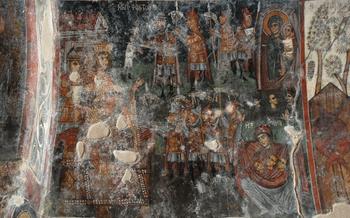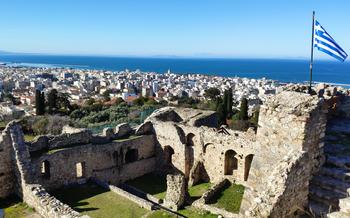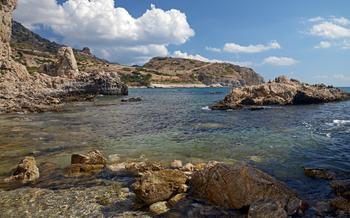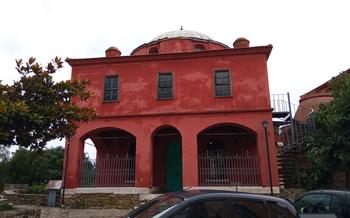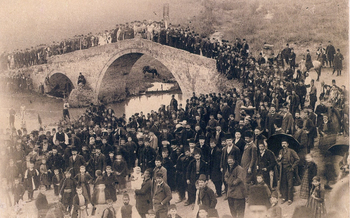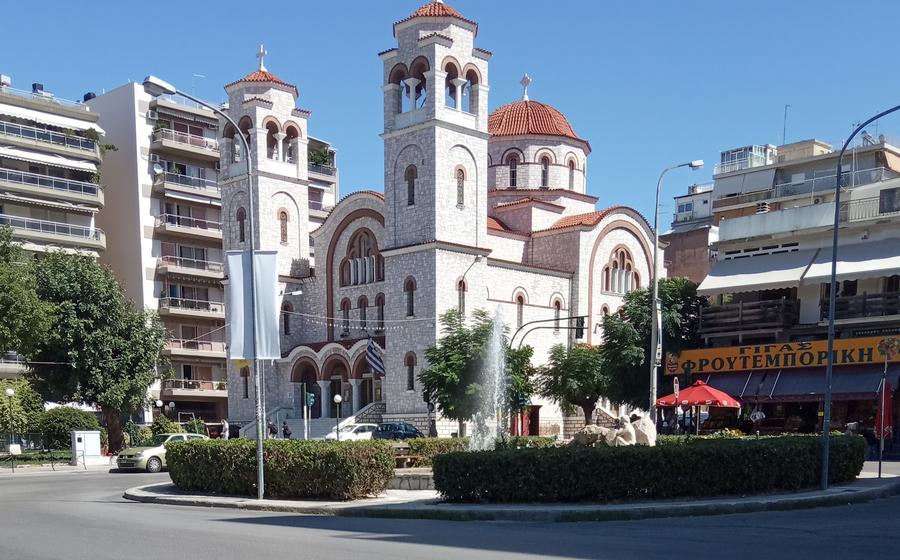
Agia Sofia Church
- Historical Significance
- Architectural Marvel
- Interior Splendor
- Religious Symbolism
- Patras' Landmark
- Local Traditions
- Tourist Attraction
- Photo Opportunities
- Accessibility
- Visiting Hours: Unveiling the Sanctuary's Schedule
- Entrance Fees
- Dress Code
- Photography Guidelines
- Guided Tours: Unveiling the Church's Secrets
- Insider Tip: Unveiling the Hidden Gems
Historical Significance
The Agia Sofia Church, standing proudly in the heart of Patras, Greece, holds a rich and captivating history spanning centuries. Its origins trace back to the 13th century when it was constructed as a Byzantine church, a testament to the region's deep Christian roots. During the Ottoman rule, the church underwent a significant transformation, serving as a mosque for over four centuries. This dual religious heritage reflects the complex history of the region and the diverse influences that have shaped Patras' cultural identity.
In the 19th century, the church underwent extensive restoration, reclaiming its status as a Greek Orthodox church. This restoration project aimed to preserve the church's unique architectural elements while honoring its historical significance. Today, the Agia Sofia Church stands as a symbol of Patras' resilience and its ability to embrace its diverse past.
Architectural Marvel
The Agia Sofia Church stands as a testament to the architectural prowess of its builders, showcasing a harmonious blend of Byzantine and Ottoman influences. Its most striking feature is its magnificent dome, towering over the city skyline and symbolizing the heavens. The dome's intricate patterns and vibrant colors create a mesmerizing effect, capturing the attention of visitors from afar.
Equally impressive are the church's intricate stone carvings, which adorn its exterior walls and depict various biblical scenes and religious symbols. These carvings showcase the exceptional craftsmanship of the Byzantine artisans and add a layer of depth and texture to the church's façade.
The arched windows of the Agia Sofia Church are another notable architectural element. These graceful arches not only allow ample natural light to flood the interior but also contribute to the church's overall aesthetic, lending it an air of grandeur and elegance. Together, these architectural elements create a visually stunning masterpiece that leaves visitors in awe.
Interior Splendor
The interior of the Agia Sofia Church is a breathtaking display of artistic mastery and religious devotion. As you step inside, your eyes are immediately drawn to the stunning frescoes and mosaics that adorn every surface. These intricate artworks, created by skilled artisans centuries ago, depict vibrant scenes from the Bible, showcasing the lives of saints, miracles of Jesus, and significant events in Christian history.
The frescoes and mosaics feature a rich palette of colors, including deep blues, vibrant reds, and golden hues. The intricate details and lifelike expressions of the figures create a sense of depth and realism, drawing viewers into the stories they portray. The central dome of the church features a majestic representation of Christ Pantocrator, with his piercing gaze and outstretched arms, symbolizing his divine authority and protection over the faithful.
The walls of the church are adorned with scenes from the life of the Virgin Mary, including her Annunciation, Nativity, and Dormition. These beautiful artworks serve as a reminder of the importance of Mary in the Christian faith and her role as a source of comfort and inspiration for believers.
The Agia Sofia Church's interior is a testament to the artistic prowess of the Byzantine and Ottoman periods. These magnificent frescoes and mosaics not only enhance the church's aesthetic beauty but also contribute to its spiritual atmosphere, creating a sense of awe and reverence that invites visitors to contemplate the divine.
Religious Symbolism
The Agia Sofia Church holds immense religious significance as a sacred space for both Christians and Muslims throughout history. During the Byzantine era, it served as a prominent Christian church, echoing with the prayers and chants of the faithful. With the arrival of the Ottoman Empire, it underwent a transformation, becoming a mosque, where Muslims gathered for worship and recited verses from the Quran. This dual religious heritage has left an indelible mark on the church, making it a symbol of religious coexistence and tolerance.
Today, the Agia Sofia Church stands as a Greek Orthodox church, welcoming worshippers from all backgrounds to seek solace and spiritual fulfillment. Its interior is adorned with intricate frescoes depicting biblical scenes, reminding visitors of the rich Christian traditions that have shaped the region. The church also retains elements of its Islamic past, such as the mihrab, a niche indicating the direction of Mecca, highlighting the enduring legacy of the Ottoman era.
The Agia Sofia Church is a living testament to the complex religious history of Patras. It serves as a reminder that even amidst differences in faith, common ground can be found through shared values and a mutual respect for religious beliefs.
Patras' Landmark
The Agia Sofia Church stands as a prominent landmark in the heart of Patras, Greece. Centrally located within the city center, its distinctive silhouette catches the eye from various vantage points. The church's imposing architecture and rich history have made it an iconic symbol of Patras' cultural heritage. Whether viewed from afar or admired up close, the Agia Sofia Church serves as a testament to the city's rich past and its enduring significance. It invites visitors to step back in time and explore the layers of history that have shaped Patras into the vibrant city it is today.
Local Traditions
The Agia Sofia Church is deeply intertwined with the local traditions and customs of Patras. Each year, the church plays host to a variety of religious festivals and celebrations that attract both locals and tourists alike. One of the most notable events is the annual feast of Agia Sofia, held on September 17th. During this festival, the church is adorned with colorful decorations, and a grand procession takes place through the streets of Patras, carrying the icon of Agia Sofia. Locals and visitors gather to participate in the procession, paying homage to the patron saint of the city. These festivals and celebrations are not only a testament to the church's religious significance but also a vibrant expression of Patras' rich cultural heritage, bringing the community together in a spirit of joy and devotion.
Tourist Attraction
As a prominent tourist attraction in Patras, the Agia Sofia Church draws visitors from around the world. Its inclusion in guided city tours makes it a popular stop for those seeking to explore the city's rich history and architecture. The church's unique blend of Byzantine and Ottoman influences captures the attention of visitors, making it a must-see destination for those interested in religious landmarks. Whether you're a history buff, an architecture enthusiast, or simply seeking a spiritual experience, the Agia Sofia Church offers a rewarding and memorable visit.
Photo Opportunities
The Agia Sofia Church offers a plethora of picturesque views and photo opportunities that will delight any photography enthusiast. Its stunning exterior, adorned with intricate carvings and arches, provides a captivating subject for capturing the essence of Patras' architectural heritage. The charming surroundings of the church, with its narrow cobblestone streets and traditional Greek houses, create a picturesque backdrop for capturing the essence of the city's old town.
Venture to the church's bell tower, where you'll be rewarded with panoramic city views that stretch from the Gulf of Patras to the surrounding mountains. Capture the vibrant energy of the city as locals go about their daily lives, or immortalize the breathtaking sunsets that paint the sky in hues of gold and purple. Whether you're a seasoned photographer or simply looking to capture some memorable moments, the Agia Sofia Church offers a treasure trove of photo opportunities that will leave you inspired.
Accessibility
Reaching the Agia Sofia Church is a breeze, thanks to its prime location in the heart of Patras. Whether you prefer public transportation or the convenience of your own vehicle, you'll find it easily accessible. Numerous bus routes stop nearby, making it a breeze to get there without the hassle of parking. And if you're driving, there are ample parking options within walking distance. The church's central location also allows you to seamlessly explore other nearby attractions, creating a delightful itinerary for your day in Patras.
Visiting Hours: Unveiling the Sanctuary's Schedule
The Agia Sofia Church welcomes visitors with open arms, inviting them to explore its sacred spaces during specific hours. The church's doors are open to the public from 8:00 AM to 1:00 PM and from 5:00 PM to 8:00 PM every day of the week. These hours allow ample time for visitors to immerse themselves in the church's rich history, admire its architectural marvels, and experience its spiritual ambiance.
During the summer months, from June to September, the church extends its visiting hours to accommodate the influx of tourists. The extended hours are from 8:00 AM to 12:00 PM and from 5:00 PM to 9:00 PM, providing visitors with even more opportunities to marvel at the church's splendor.
It's important to note that the church may have special arrangements or closures during religious services, festivals, or events. To ensure a smooth and enjoyable visit, it's recommended to check the church's official website or contact local tourism offices for the most up-to-date information on visiting hours and any potential changes.
Entrance Fees
Visiting the Agia Sofia Church is free of charge, allowing everyone to experience its historical and cultural significance without financial barriers. This open-door policy encourages both locals and tourists to explore the church's sacred spaces and admire its architectural beauty. However, donations are gratefully accepted and play a vital role in the ongoing preservation and maintenance of this remarkable landmark. These contributions help ensure that future generations can continue to appreciate the church's unique heritage and spiritual atmosphere.
Dress Code
When visiting the Agia Sofia Church, it is important to adhere to the appropriate dress code out of respect for the sacred nature of the site. Visitors are expected to dress modestly, covering their shoulders and knees. This dress code is in accordance with religious customs and helps maintain a respectful atmosphere within the church. Revealing or overly casual clothing is not suitable for this sacred space. By dressing appropriately, visitors can show their respect for the church's religious significance and contribute to a peaceful and reverent environment.
Photography Guidelines
When visiting the Agia Sofia Church, it is important to be mindful of the sacred atmosphere and respect the privacy of other visitors. Photography is generally permitted within the church, but there are a few guidelines to follow.
Flash photography is not allowed, as it can be disruptive to religious services and damage the delicate artworks. Tripods and selfie sticks are also prohibited, as they can obstruct the movement of other visitors and cause damage to the church's interior.
It is important to be respectful of the church's religious significance and avoid taking photos during services or ceremonies. If you wish to take photos of specific artworks or features, it is advisable to ask permission from a church official or guide.
By adhering to these guidelines, visitors can help preserve the sanctity of the Agia Sofia Church and ensure a peaceful and enjoyable experience for all.
Guided Tours: Unveiling the Church's Secrets
To fully immerse yourself in the history and significance of the Agia Sofia Church, consider joining a guided tour. Experienced guides offer insightful commentary, delving into the church's architectural features, religious symbolism, and stories from its past. They can point out hidden details and share anecdotes that bring the church's rich heritage to life.
Booking a guided tour in advance is recommended, especially during peak tourist season. It ensures a spot on the tour and allows you to plan your visit more effectively. Whether you're a history buff, an architecture enthusiast, or simply curious about Patras' cultural heritage, a guided tour of the Agia Sofia Church will provide a deeper understanding and appreciation of this remarkable landmark.
Insider Tip: Unveiling the Hidden Gems
Discover the hidden charm of Agia Sofia Church by exploring the nearby streets and uncovering unique perspectives. Take a leisurely stroll down Agiou Nikolaou Street, where you can admire traditional Greek architecture and stumble upon quaint cafés and shops. If you're visiting during the summer months, head to the picturesque Rio Beach, just a short drive from the church, to enjoy breathtaking views of the Gulf of Patras. For a truly immersive experience, attend one of the church's annual religious festivals, such as the Feast of the Assumption in August, where you can witness vibrant processions, traditional music, and dancing. These hidden gems offer a glimpse into the local culture and provide a memorable experience beyond the walls of the church.

